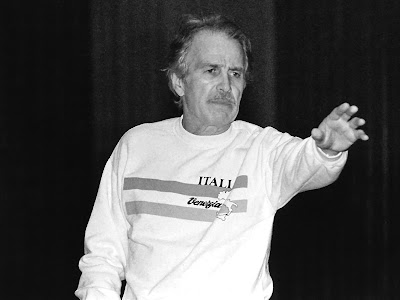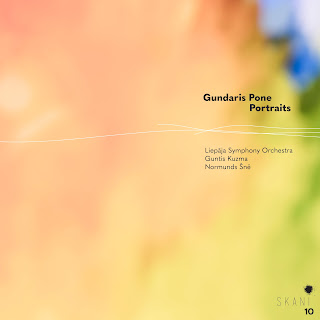Gundaris Pone: La Serenissima, seven Venetian portraits for orchestra, American Portraits, Avanti!; Liepāja Symphony Orchestra, Guntis Kuzma, Normunds Šnē; SKANI
Reviewed 22 July 2024
The first studio recordings of three of Gundaris Pone’s large-scale orchestral works reveal a mid-20th century composer of great imagination writing European music yet with his roots in Latvia
Latvian-American composer Gundaris Pone wrote music that transcended his country of birth. Born in Riga, his family emigrated to America in 1950, fleeing the advancing Soviet troops, and it was here that Pone trained and lived. Latvian music up until the second half of the 20th century largely reflected a mood of national romanticism, so Pone’s music seemed to many like the avantgarde of its time, yet Pone himself believed that Latvia was the true place for his scores.
Of his style, Pone would say in an interview that though he was labelled an avantgardist, he had never considered himself so, that he thought “music should be written for the broadest masses of people, including those who haven’t been specially educated in music.”
This album from the Latvian Music Information Centre‘s SKANI label features world premiere studio recordings of works for large orchestra La Serenissima, American Portraits and Avanti! All written between 1971 and 1984. The performers are the Liepāja Symphony Orchestra, conductors Guntis Kuzma and Normunds Šnē.
We begin with La Serenissima, seven Venetian portraits for orchestra, a work that won competitions in Trieste in 1981 and in Louisville in 1983 as well as the Witney prize. Venice held a special place in the composer’s heart and in later life he divided his time between the city and the USA. The work’s material revolves around five notes, A – E flat – E – D – B, evidently spelling out LA S(es)-E-RE-nisSIma. The language is richly evocative and lush, even though the style is definitely modernism. But I kept getting hints of Britten’s intelligent use of 20th century modernism too, here is a composer viewing European music through distinctly individualistic glasses. The work is in seven parts, each with an Italian title though for convenience I refer to the English translations.
 |
| Gundaris Pone |
Part 1, The dialectic of morning shadows: in the streets and squares, is distinctly evocative, full of distinctive timbres and textures, richly complex harmonies. Part 2, Lyrical Venice: the Arch of Paradise remains complex yet transparent, contrasting wildly with the vivid trumpets at the opening of Part 3, Severe Venice: the mouth of the lion, which merges violence with vibrant dance. Part 4, The dialectic of afternoon waters, is delicate yet busy and quasi-nocturnal whilst Part 5, A meeting with the messenger of death on the island of San Michele moves into real night music, or perhaps nightmare music. Part 6, Evening chatter on San Bartolomeo Square is all vivid scurrying yet with something eerie about it too, what are these people chattering about. Finally, Part 7, The dialectic of night fog: spectral Venice, which has an underlying rhythmic structure with more slithering music over, again I had thoughts about Britten and his fondness for passcaglia structure, but also get surprising fragments of popular songs.
This is large scale, complex music yet such is the evocative, almost descriptive nature of Pone’s writing that despite the complexity the music has great appeal. Full of timbres and textures, Pone uses his orchestra with great idiosyncratic skill. Why don’t we know this music more? The performers on the disc gave the work’s Latvian premiere in May 2023, so it is not surprising if others have not picked it up, yet.
We don’t know that much about the origins of Pone’s American Portraits. Written in 1983-84, the composer stated in a letter that the work was to be performed by the Baltimore Symphony Orchestra in the 1985-86 season, but the first known performance is by the Louisville Symphony Orchestra in 1986. Evidently Pone stated that he had portrayed five Americans: an inventor, a famous film star, a powerful financier, a gangster and a military genius. All legendary – some in a good way, others in a bad way. No more details!
The work is in five movements, each vividly characterised and perhaps slightly harder edged and less evocative than La Serenissima but still Pone’s writing is vivid and eclectic. He isn’t frightened of hard modernist sounds, yet can continue with a quote from Five Foot Two, Eyes of Blue composed by Ray Henderson, which Pone notes should to be performed in a 1920s style. It is this sheer eclecticism and vivid imagination that appeals.
The final work on the disc Avanti! is the earliest, dating from 1975. Avanti! was commissioned for the 1975 Latvian Song Festival in Toronto, but the event’s organising committee rejected the composition. Judging by contemporary articles, the organisers of the 1983 Song Festival in Milwaukee were of the same mind – Avanti! was not performed for political reasons, and also the piece turned out to be too difficult to be played with the musical resources available. Pone has a clear dialectic and perhaps didactic aim in the piece, he uses a motif from the Latvian 1905 revolutionary song With Battle Cries on Our Lips to an effect that we might see as political. Perhaps this is a good moment to remember that Pone, at various times, called himself a socialist, a Marxist, a communist.
The highly informative booklet quotes musicologist Sofija Vēriņa recalling, in 1990, Pone’s first visit to Latvia in 1971 (at the height of the Soviet period), “The main issue was not the art of this visitor, but what political status he should be given. The emigrant (who at the age of eleven had fled into exile with his parents). The avantgardist (unacceptable to us). Yes, very progressive, so a humanist (but not a Marxist). A Trotskyist!, finally decided the Latvian Committee for Cultural Relations with Compatriots Abroad. However, the composer was received very kindly, with the authorities trying to adapt the universal humanist ideas in his work as best as possible to the official [Soviet] propaganda. Thus Gundaris Pone (like his friend and colleague [the eminent Italian composer Luigi] Nono) found himself in a paradoxical position: here, due to his high humanistic potential, he was considered ideologically ‘correct’ but technically misguided, whereas some compatriots abroad saw him as ideologically misguided but technically ‘correct’.” The mention in Nono is intriguing, as here is another composer who combined complexity with a lack of dogma and a sense of vivid imagination.
Other elements in Avanti include, disturbingly, a cuckoo, and a quotation of Bach’s mournful chorale O Traurigkeit, o Herzeleid, of which Pone said, “That is all I can do within my philosophy. Because after all, we do not know what the final answer will be; we can only stand before the question mark.”
The Liepāja Symphony Orchestra, conductors Guntis Kuzma (for La Serenissima and American Portraits) and Normunds Šnē (for Avanti!) do Pone proud. This is a vividly realised recording which does full justice to the complexity and vivid imagination of this music.
Gundaris Pone (1932-1994) – La Serenissima, seven Venetian portraits for orchestra
Gundaris Pone – American Portraits
Gundaris Pone – Avanti!
Liepāja Symphony Orchestra
Conductors Guntis Kuzma and Normunds Šnē
Recorded at Great Amber Concert Hall, Liepāja, 8–9 January 2024, February 20-22, 2024, February 27-29, 2024
SKANI LMIC162 1CD [67:11]
Never miss out on future posts by following us
The blog is free, but I’d be delighted if you were to show your appreciation by buying me a coffee.
Elsewhere on this blog
- Returning to Northern Ireland Opera for his third role, British-Ukrainian baritone Yuriy Yurchuk talks about his continuing exploration of Tchaikovsky’s Eugene Onegin – interview
- Relentlessly entertaining: A new production of Handel’s Acis and Galatea at Opera Holland Park rather over-eggs things but features finely engaging soloists – opera review
- Contemporary contrasts: Wolf-Ferrari’s Il segreto di Susanna & Leoncavallo’s Pagliacci in a satisfying double bill at Opera Holland Park – opera review
- A sound world that is distinctive, appealing & engaging: Maria Faust’s Mass of Mary on Estonian Record Productions – record review
- A rich sophistication of thought running through this programme that seems worlds away from the typical debut recital: Awakenings from Laurence Kilsby & Ella O’Neill – record review
- Fine singing and vivid character: a revival of John Cox’s vintage production of Mozart’s Le nozze di Figaro at Garsington – opera review
- An intuitive abstract Sudoku working with sound parameters and with no single solution: Chilean composer Aníbal Vidal on writing music – interview
- Youth, experience and a warm reception: our visit to the Glasperlenspiel Festival in Tartu, Estonia – concert review
- Sustainable Opera for the Future by Max Parfitt of Wild Arts – guest article
- As vivid and vigorous as ever: David McVicar’s production of Handel’s Giulio Cesare returns to Glyndebourne with a terrific young cast – opera review
- Expressionism and rigour: soprano Claire Booth on recording Pierrot Lunaire and the importance of exploring Schoenberg’s songs – interview
- Home









